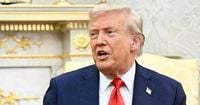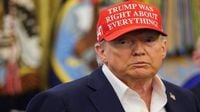President Donald Trump’s latest announcement—to allow 600,000 Chinese students to study at American universities—has ignited fierce debate across the political spectrum, especially among his own supporters. The move, revealed during high-profile meetings at the White House this week, marks a striking pivot from the administration’s prior hardline stance on foreign student visas and comes at a moment of delicate U.S.-China relations, with trade talks and national security concerns simmering in the background.
On August 25, 2025, during a meeting with South Korean President Lee Jae Myung in the Oval Office, Trump surprised many by stating, “I hear so many stories about ‘We are not going to allow their students,’ but we are going to allow their students to come in. We are going to allow it. It’s very important — 600,000 students.” According to the Associated Press, Trump doubled down at a Cabinet meeting the next day, sitting beside Secretary of State Marco Rubio, emphasizing, “I told this to President Xi that we’re honored to have their students here. Now, with that, we check and we’re careful, we see who is there.”
The scale of the proposal is eye-catching. The figure of 600,000 Chinese students is more than double the current number of Chinese nationals enrolled in U.S. institutions; the latest figures from the 2023 academic year put that number at 277,398, down from a peak of 372,532 in 2019-2020. As reported by Fox News and Nexstar Media, the number of Chinese students in the U.S. has been declining for several years, reflecting both tightening visa restrictions and broader geopolitical tensions.
Trump’s remarks represent a sharp reversal from earlier administration policies. Secretary of State Marco Rubio had announced in May that the State Department would “aggressively revoke visas for Chinese students, including those with connections with the Chinese Communist Party or studying in critical fields.” The administration had previously expanded grounds for terminating international students’ ability to study in the U.S. and blocked foreign enrollment at certain universities, including Harvard, over concerns about espionage and technology transfer.
The president’s new openness, however, is not without context. Trump linked the proposed influx of Chinese students to ongoing trade negotiations with Beijing, suggesting that educational exchange could be a bargaining chip in efforts to resolve disputes over tariffs, rare earths, and supply chains. “We’re getting along very well with China, and I’m getting along very well with President Xi,” Trump said, according to Fox News. “I think it’s very insulting to say students can’t come here.” He even hinted at plans to visit China later in 2025 or “shortly thereafter.”
Yet the proposal has provoked a swift and vocal backlash from prominent voices within Trump’s own “Make America Great Again” base. Representative Marjorie Taylor Greene, a Republican from Georgia, posted on social media, “We should not let in 600,000 CHINESE students to attend American colleges and universities that may be loyal to the CCP. If refusing to allow these Chinese students to attend our schools causes 15% of them to fail then these schools should fail anyways because they are being propped up by the CCP.”
Other conservative personalities echoed this sentiment. Former Trump adviser Steve Bannon declared, “There should be no foreign students here for the moment.” Far-right activist Laura Loomer went further, claiming, “Nobody, I repeat nobody, wants 600,000 more Chinese ‘students’ aka Communist spies in the United States.” Even Fox News host Laura Ingraham pressed Commerce Secretary Howard Lutnick on her show, “How is allowing 600,000 students from the communist country of China putting America first?”
Lutnick, defending the administration’s pivot, argued that the presence of foreign students is critical to the financial survival of many American universities. “The president’s point of view is that what would happen if you didn’t have those 600K students is that you’d empty them from the top, all the students would go up to better schools, and the bottom 15% of universities and colleges would go out of business in America,” he told Ingraham. “He’s taking a rational economic view, which is classic Donald Trump.”
Indeed, the economic stakes are significant. An analysis by NAFSA, an association of international educators, found that international students contributed $43.8 billion to the U.S. economy and supported 378,175 jobs during the 2023-2024 academic year. Trump himself underscored this point, stating, “And you know what would happen if they didn’t (come)? Our college system would go to hell very quickly and it wouldn’t be the top colleges. It would be colleges that struggle on the bottom.”
Yet critics argue that the policy could displace American students and risk national security. Joe Chatham, director of government relations at the Federation for American Immigration Reform, told Fox News Digital, “Granting 600,000 student visas to Chinese nationals threatens to put foreign students ahead of U.S. graduates. The focus now must be on reforms to limit access to sectors crucial to our economy and national security that have repeatedly been the target of corporate espionage and intellectual property theft—not expanding access to hostile countries.”
These concerns are not new. During his first term, Trump banned Chinese graduate students who had attended schools with Chinese military ties. And there is a growing bipartisan consensus that U.S. schools should not help train Beijing’s top talent in fields such as quantum computing, artificial intelligence, and aerospace technology. Kurt Campbell, deputy secretary of state in the Biden administration, has even said he would prefer Chinese students study humanities and social sciences, “not particle physics.”
On the other side of the Pacific, Chinese officials have decried U.S. visa restrictions as discriminatory. Mao Ning, a Chinese foreign ministry spokesperson, said on August 22, “The U.S.’s moves severely violate the legitimate and lawful rights and interests of Chinese nationals, impede the flow of people between the two countries and dampen China-U.S. people-to-people exchanges.” The Chinese Embassy in Washington issued an advisory on August 25, warning students against entering the U.S. through Houston’s George Bush Intercontinental Airport after reports of harassment and extended interrogations by customs officials.
The debate is not just about economics or security; it’s also about the future of American higher education and the country’s global standing. Some commentators, like podcast host Joshua Reid, see an upside: “Chinese students on U.S. visas aren’t average kids. They represent the top tier of China’s youth... American culture returns home with them. When you start to think about emergent tech, this is actually a great idea. Bring the top level students over the US. This is talent that is pulled away from China and now becomes a national asset.”
For now, Trump’s proposal remains a flashpoint—an emblem of the complex balancing act between economic pragmatism, national security, and the enduring power of educational exchange. With the White House and State Department yet to clarify the details, the future of Chinese students in the U.S. will remain a hotly contested issue as trade talks and political campaigns intensify.

